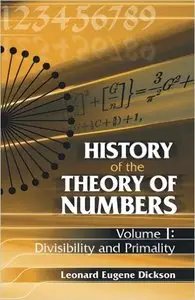Leonard Eugene Dickson, "History of the Theory of Numbers, Volume I: Divisibility and Primality"
2005 | ISBN-10: 0486442322 | 512 pages | PDF | 38 MB
2005 | ISBN-10: 0486442322 | 512 pages | PDF | 38 MB
This 1st volume in the series History of the Theory of Numbers presents the material related to the subjects of divisibility and primality. This series is the work of a distinguished mathematician who taught at the University of Chicago for 4 decades and is celebrated for his many contributions to number theory and group theory. 1919 edition.
The three-volume series History of the Theory of Numbers is the work of the distinguished mathematician Leonard Eugene Dickson, who taught at the University of Chicago for four decades and is celebrated for his many contributions to number theory and group theory. This first volume in the series, which is suitable for upper-level undergraduates and graduate students, is devoted to the subjects of divisibility and primality. It can be read independently of the succeeding volumes, which explore diophantine analysis and quadratic and higher forms.
Within the twenty-chapter treatment are considerations of perfect, multiply perfect, and amicable numbers; formulas for the number and sum of divisors and problems of Fermat and Wallis; Farey series; periodic decimal fractions; primitive roots, exponents, indices, and binomial congruences; higher congruences; divisibility of factorials and multinomial coefficients; sum and number of divisors; theorems on divisibility, greatest common divisor, and least common multiple; criteria for divisibility by a given number; factor tables and lists of primes; methods of factoring; Fermat numbers; recurring series; the theory of prime numbers; inversion of functions; properties of the digits of numbers; and many other related topics. Indexes of authors cited and subjects appear at the end of the book.



